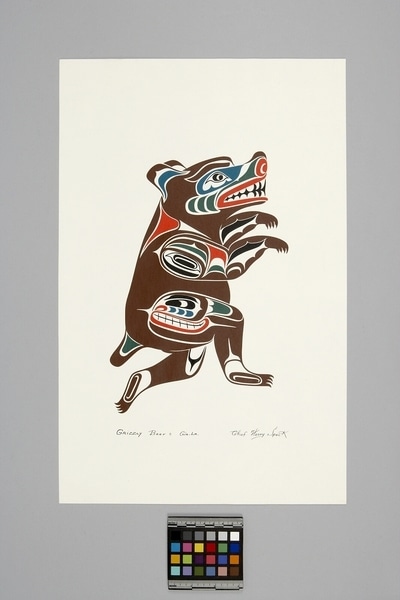Grizzly Bear, Gia-La Item Number: Nb3.1402 from the MOA: University of British Columbia

Description
Silkscreen print with a configurative design of brown bear in Kwakwaka'wakw style. Bear is in profile and facing to the right side. Most of the body is solid brown and negative spaces are left as irregular ovoids on the feet and on the back of the knees. Multi-coloured head, fore, and hind limbs. U forms and split u's used near all the joints including the tail which has green solid u form. Forelimb is raised with eye and eyebrow ovoids. Upper hind limb has the face of a bear with a red mouth and nostrils, teeth, and green ears in split u's. Black inscription below image. The print is on vertically rectangular, off-white paper.
History Of Use
Northwest Coast print making is a relatively new art form, which began in the late 1940's, but did not develop until the late 1960's. The establishment of the Northwest Coast Indian Artists Guild, in 1977, aided the implementation of standards in limited addition runs and various aspects of quality control. Silk-screen prints have been used to portray traditional and contemporary themes, as well as, to make personal statements. Kwakwaka'wakw artists have, in general, preferred to work with traditional crest designs and mythical themes. More colours are used by Kwakwaka'wakw artists than are used by northern Northwest Coast artists, and the images are composed of many small elements combining into relatively realistic or configurative forms.
Cultural Context
contemporary art
Iconographic Meaning
Bears are the subject of many legends and are portrayed with powerful, human-like qualities. They are also important family crest animals. The identifying features are the ears, large flaring nostrils, wide mouth with teeth, canines, and claw-like fore and hind limbs.
Narrative
Nb3.1335 to Nb3.1343 were given to Audrey Hawthorn in 1973. This collection of Henry Speck prints is from an unnumbered collection probably printed in the 1960's.
Item History
- Made by Chief Henry Speck (Maker) in British Columbia, Canada during 1962
- Collected during 1973
- Owned by Audrey Hawthorn before June 21, 1976
- Received from Audrey Hawthorn (Donor) on June 21, 1976
What
- Name
- Grizzly Bear, Gia-La
- Identification Number
- Nb3.1402
- Type of Item
- Manufacturing Technique
- silkscreened
- Overall
- height 48.2 cm, width 31.2 cm, depth 0.1 cm
Who
- Culture
- Kwakwaka'wakw
- Creator
- Chief Henry Speck (Maker)
- Previous Owner
- Audrey Hawthorn
- Received from
- Audrey Hawthorn (Donor)
Where
- Holding Institution
- MOA: University of British Columbia
- Made in
- British Columbia, Canada
When
- Creation Date
- during 1962
- Collection Date
- during 1973
- Ownership Date
- before June 21, 1976
- Acquisition Date
- on June 21, 1976
Other
- Item Classes
- works on paper
- Condition
- fair
- Current Location
- Case 38
- Accession Number
- 0309/0006